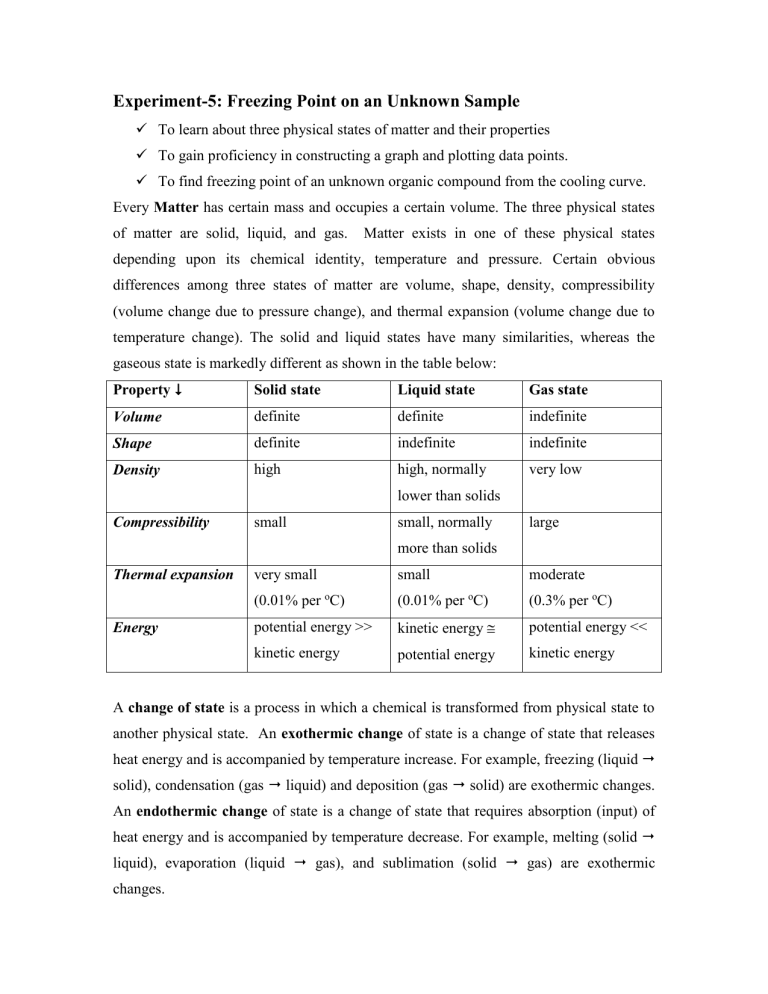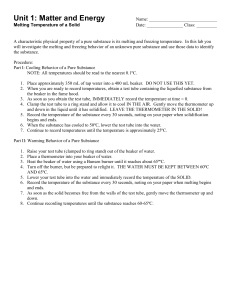Freezing Point of an Unknown Sample

Experiment-5: Freezing Point on an Unknown Sample
To learn about three physical states of matter and their properties
To gain proficiency in constructing a graph and plotting data points.
To find freezing point of an unknown organic compound from the cooling curve.
Every Matter has certain mass and occupies a certain volume. The three physical states of matter are solid, liquid, and gas. Matter exists in one of these physical states depending upon its chemical identity, temperature and pressure. Certain obvious differences among three states of matter are volume, shape, density, compressibility
(volume change due to pressure change), and thermal expansion (volume change due to temperature change). The solid and liquid states have many similarities, whereas the gaseous state is markedly different as shown in the table below:
Property
Solid state Liquid state
Volume definite definite
Shape
Density definite high indefinite high, normally lower than solids
Gas state indefinite indefinite very low
Compressibility small small, normally more than solids large
Thermal expansion very small
Energy
(0.01% per o
C) potential energy >> kinetic energy small
(0.01% per o
C) kinetic energy
potential energy moderate
(0.3% per o
C) potential energy << kinetic energy
A change of state is a process in which a chemical is transformed from physical state to another physical state. An exothermic change of state is a change of state that releases heat energy and is accompanied by temperature increase. For example, freezing (liquid
solid), condensation (gas
liquid) and deposition (gas
solid) are exothermic changes.
An endothermic change of state is a change of state that requires absorption (input) of heat energy and is accompanied by temperature decrease. For example, melting (solid
liquid), evaporation (liquid
gas), and sublimation (solid
gas) are exothermic changes.
Identifying an unknown compound is a tedious task which requires measurements of several physical and chemical properties of the compound. Some important physical properties that are often utilized by chemists in identifying an organic compound are color, odor, physical state, melting point, boiling point, density, refractive index, infrared spectrum, nuclear magnetic spectrum and ultraviolet spectrum. Physical constants are numerical values measured under standard conditions (temperature, pressure, etc.), which can be found in CRC Handbook .
Crystalline solids are composed of atoms, ions, or molecules in a highly ordered geometric pattern (crystal lattice). The atoms, ions or molecules are held in their positions by electrostatic, dipole and/or London forces. When a pure crystalline solid is heated, the atoms, ions or molecules vibrate more and more rapidly until at a definite temperature the thermal mot ion of the particles becomes great enough to overcome the forces of attraction. Then the atoms, ions or molecules enter a more random and mobile state, the liquid state. Then melting (solid
liquid) transition occurs.. This temperature is referred to as the melting point . The freezing point and the melting point of a substance have the same value, theoretically. Useful information as to the compound's identity and its purity can often be obtained from its melting point. A solid is said to melt sharply if the melting point range is 0.5 - 1.0 deg. C. A pure solid will generally melt sharply because the forces of attraction between its particles are the same. However, the presence of a foreign particle in a crystal lattice interrupts its uniform structure and the forces of attraction are weakened. An impure solid melts at a lower temperature and over a wider range .
Suppose two compounds X and Y have identical melting point of 135 o C each. One can easily determine whether or not X and Y are the same or two different compounds by mixing a small amount of X with Y (or vice versa) and finding the melting point of the mixture ( mixture melting point ). If X and Y are the same compounds, the mixture melting point will be 135 o
C. If X and Y are two different compounds the mixture melting point will be much lower than 135 o C and will not be melt sharply.
In this experiment, first you will melt an unknown organic solid in a hot water bath and then allow the liquid to air cool. During the cooling process, you will record the temperature every 30 seconds and the reappearance of solid will take place. The data will
then be plotted on a graph paper (titled and well labeled). The plot will show the time along the horizontal axis {x-axis} and the temperature on the vertical axis {y-axis).
Each point will be circled and a smooth cooling curve connecting or passing through maximum points will be drawn. An extrapolation of the flat portion of the curve to the vertical axis will give the value of the freezing point as shown below:
"Cooling Curve"
Unknown Organic Soild
Freezing point time (seconds)
The freezing point thus found can be used to identify you unknown sample by comparison.
Compound
Benzophenone mp or fp ( o C)
49-51
Steric acid
Vanillin
69-70
80-81
Naphthalene
1-Naphthol
Paradichlorobenzene
Biphenyl
Palmitic Acid
80-82
95-96
54-56
69-71
61-64
Procedure:
1.
Students may work in pairs. No flames are allowed in this experiment. Only electrical hot plates will be used. Do not touch hot beakers or test tubes. There is no chemical waste in this experiment. After you finish your work, replace the testtube containing the chemical, thermometer, and the copper-wire. Review the figure given below carefully:
2.
Each pair needs only one set up. Set up 400-mL beaker containing about 300 mL water on top an electrical hot plate. Obtain a big test tube containing the unknown organic solid, a thermometer, and a copper wire stirrer. Clamp this test tube and immerse in water. Now, start heating. Do not boil the water. After the entire solid has melted, shut-off the electrical hot plate and unplug the electrical hot plate. Now, carefully raise the test tube out of the hot water. Begin recording the temperature every thirty seconds for ten minutes. It is necessary to stir the liquid using the copper wire stirrer every 10 seconds or so. You will notice that the temperature readings will drop as the time passes by and the liquid inside the test tube will turn into a solid. In some cases it may take more than 10 minutes.
3.
Plot the temperature vs. time data on the graph paper provided.
4.
Replace the test tube.
Laboratory Report#5: Freezing Point on an Unknown Sample
Last Name_____________________________, first name________________
Date of Experiment___________ Instructor’s Initials_______
8.5
9.0
9.5
10.0
5.0
5.5
6.0
6.5
7.0
7.5
8.0
3.0
3.5
4.0
4.5
Time (min)
0.0
0.5
1.5
2.0
2.5
Data
Your Unknown Sample Number:__________________
Temperature ( o C) Physical state (solid, liquid or both)
Cooling Curve for Unknown #__________ Freezing Point from this graph =________ o
C
[Y- axis: temperature (1 o
C/box), X-axis: time (30 sec/box)].
Last Name__________________________, first_________________date____________
Show all your work and use proper units and significant figures!
1.
What are the applications of finding the melting point of an organic compound?
2.
What is the effect of impurity on the melting point value?
3.
The freezing point of ethyl alcohol is -117 o
C. Express this in o
F and K units.
4.
Give the names of three exothermic and three endothermic processes.







